|
A Horse
of A Different Color
Reprinted with permission
By
Bea Kinkade
© Copyright 1999,
Voice of the Tennessee Walking Horse, Lewisburg, Tennessee
Reprinted with permission from Bea Kinkade
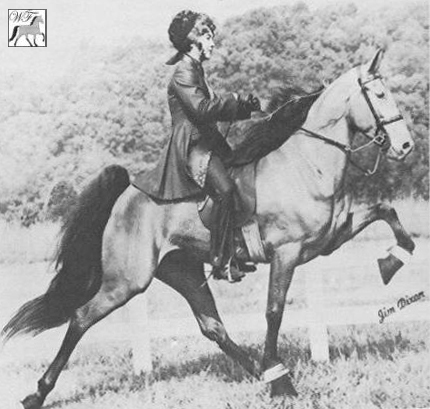 Every
once in a while, nature gives us a wonderful gift. Sometimes
it's the result of years of human research and diligence
. . . a new variety of rose for example. And sometimes it's
just luck. Every
once in a while, nature gives us a wonderful gift. Sometimes
it's the result of years of human research and diligence
. . . a new variety of rose for example. And sometimes it's
just luck.
On June 19, 1969, nature gave the walking
horse world such a gift. A filly was born. By
Johnny Midnight
and out of Mack's Golden Girl, the baby was an odd color,
like sparkling amber champagne, with chocolate points and
bright blue eyes that eventually turned amber. She was Champagne
Lady.
In 1970 Diane Green of Summerhill
Farm, Tullahoma, Tennessee, saw the 18 month old filly tied
to a trailer at a horse show. Diane came running back to
her mother, exclaiming, "Mother, come look - I've just
seen the most beautiful, different-colored filly. You won't
believe your eyes. I've never seen anything like her. And
I'm going to buy her!"
The Greens had several
top show horses in training, notably Delight's Magic Moment,
who became the 1971 World Champion Junior Mare. Diane's
mother, Kelly, though impressed with the quality, pedigree,
and certainly the filly's unusual color, tried unsuccessfully
to discourage the purchase. But Diane was going to have
that filly!
Champagne Lady proved to be a wise investment.
She was put into training with Marianne Leech and soon became
well known for her blue ribbons. She won the two year old
class at Montgomery, Alabama her first time in the show
ring. She went on to win classes at 23 major shows, in Tennessee,
Alabama, Georgia and Kentucky. Many of you remember seeing
her.
Diane was curious about her mare's color. What
was it, exactly? Everyone had a guess, but no one knew for
sure. So she submitted hair samples to the University of
Tennessee at Knoxville, and later to Auburn University at
Auburn, Alabama. The samples were independently tested,
and through microscopic comparison and elimination both
laboratories agreed that the color could not be officially
classified, that they had no typing for the mare's color
gene. Champagne Lady was a color unique unto herself. The
experts theorized that she was a "genetic color accident,"
truly a horse of a different color.
Even though they
could not put a name to her color, the experts could definitely
state which colors she was not. She was not roan, gray,
claybank, red dun, buckskin, perlino, isabella or grulla.
Champagne Lady had proved herself in the show ring,
but would she pass on her great abilities when she retired
to become a broodmare? Would she pass on her unusual color?
Her first foal was a black filly, Eb's Champagne Velvet.
She topped the 1980 Wiser Farm Sale and went on to make
a good show mare. In 1989 Velvet was bred and foaled a black
stud colt. They were entered and tied seventh in the highly
competitive mare and foal class at the 1990 Celebration.
Champagne Lady's second foal was a black colt by
Pride Of Midnight
H. F. He was injured as a weanling and had
to be put down.
Meanwhile she had been bred back
to Pride Of Midnight
and April, 1979 delivered a black stallion, Pride's Champagne.
(More about him later).
Her fourth foal was by
Carbon Copy.
It was a filly. A champagne-colored filly! This was the
first indication that Champagne Lady could transmit her
color! This filly, Champagne Copy, also made a good show
horse and then was retired to be a broodmare.
Champagne Lady was proving
herself as a broodmare as well as a show mare. She was producing
exceptionally talented horses and was proven capable of
propagating her color.
Meanwhile, the Greens had put "the
greatest horse they'd ever raised," (their very words),
Pride's Champagne, in training. Their hope, faith, time
and belief were swept away when the two-year old colt was
maliciously injured, during the night, just five days before
his show ring debut.
Going against three veterinary
advisors, including the insurance vet, Kelly and Diane refused
to put the horse down; pleading with Dr. Prince of Winchester,
Tennessee, to work with Auburn University to save him. Reluctantly,
Dr. Prince agreed to try, and kept the horse for almost
a year. Pride's Champagne came out of the tragedy terribly
blemished and scarred for life, but alive. And miracle of
miracles - he was sound!
Pride's Champagne was solid
black, with a beautiful head and long neck. He was 16.2
hands and could do a perfect four-beat running walk. He
was alive and well, but would never grace the show ring.
This is where the Kinkades enter the story. In 1983
my husband Jack and I bought Pride's Champagne and had him
shipped to California. We had been looking for an outstanding
stallion since our great Go Boy's Fancy Pants died. Pride's
Champagne was exactly what we wanted. Color was definitely
not a consideration. Jack and I have been in the walking
horse business most of our lives. Gaits, conformation, bloodlines,
and many other factors have always been more important to
us than color.
We bred Pride's Champagne to 33 outside
mares in the 1983/1984 season. The next year, when his foals
started to arrive, I noticed several were born with dark
blue eyes that later turned brown. In talking to Diane,
and hearing comments from people who had seen Champagne
Lady, I started to wonder if her unique color would pop
up in later generations. [The
champagne gene is now accepted to be a dominant gene, and
can not be hidden.] I
wanted to breed to palomino or cremello mares to see if
Pride's Champagne carried the "champagne" color
gene. These colors are not very common in walking horses,
so it was hard locating mares. Finally a dark palomino mare
was bred to him. The owner phoned to say the mare lost twin
foals at about ten months. One was black/bay and the other
was a very strange color; like nothing she'd ever seen. [The
foal could have been a buckskin, but not a champagne.]
Sometime in 1984 Diane Green
called. She said she had sold all her broodmares except
Champagne Lady. The mare had been bred a couple of times
but hadn't foaled since 1980, when she had the filly, Champagne
Copy. Like many others, I really wanted the mare but just
couldn't afford her at the time. Aside from the old mare's
outstanding ability, I was becoming more and more interested
in trying to breed these amazing-colored horses, and nothing
would have been better than owning the originator of it
all.
In November 1985 a black Senator mare had a
buckskin colt by Pride's Champagne. Close, but not what
I was looking for. It was then I decided that I wanted a
champagne-colored stallion out of old Champagne Lady or
out of her daughter, Champagne Copy. I hoped to line-breed
him to Pride's Champagne daughters and granddaughters. By
this time, we had a great selection of these outstanding
mares in our area.
About that time, the opportunity
arose to send Pride's Champagne to Tennessee, to stand at
public service. We knew the horse would be well cared for,
and it would give him an opportunity to prove what he could
produce - breeding him to some of the best mares in the
heart of walking horse country. We thought he deserved that
chance. And we were right. Pride's Champagne has sired many
outstanding foals in Tennessee, first at William Pennington's
Stable and now at Billy Gray's Sand Creek Farms in Shelbyville.
Of course, that left room at our breeding farm for another
stallion. I knew just the one I wanted.
I called
the TWHBEA, asking for the name of the registered owner
of Champagne Copy. I hoped the mare might be producing her
color. I phoned her owner, Clipper Green in Haleyville,
Alabama. He told me that he had bred the mare to his stallion
and just a few days before foaling, a storm came up and
she was struck and killed by lightening.
An autopsy
revealed she was carrying a champagne-colored filly. It
was terrible news, but I gained one piece of valuable information
- the color gene definitely would transmit down to Champagne
Lady's third generation. Another thing I learned - Clipper
Green told me he heard that Larry Massey was working a young
champagne-colored stallion. If this was true, the colt had
to be out of Champagne Lady!
With the death of Champagne
Copy, there was only one horse in the world that I knew
was the champagne color, Champagne Lady herself. If the
rumor of the young stallion was true, that would make two
of them.
Once again I called the Breeder's Association,
asking for the new owner of Champagne Lady. I was told Wiley
Bailey of Little Rock, Arkansas had bought the mare from
Diane and Kelly Green.
I called Wiley. I could hardly
contain my excitement when he confirmed that there was indeed
a two-year-old son, the same color as the old mare. Also,
Champagne Lady had a black yearling filly by her side and
was in foal to the great amateur horse, Royal Senator, by
Ebony's Senator.
The foal was due in mid-April 1989.
The bad news
was Wiley did not want to sell his two year old stallion.
Knowing Champagne Lady was safe in foal, I impatiently waited
until the end of April before calling Wiley for the results.
Yes, she'd had a big champagne-colored colt. Great! But
Wiley wouldn't think of selling him. Not so great. However,
he was going to breed the mare back in a couple of months,
so maybe I still had a chance to own my champagne stallion.
Alright, have you been counting? We now have three champagne-colored
horses. The old mare, her now three-year old son, Champagne
Night, and the newborn stud colt, by Royal Senator. Remember,
we would have had five if Champagne Copy and her unborn
filly had not been killed.
I could not give up the
dream of owning a champagne-colored stallion. In late summer,
1989, I called Wiley again. He told me he had bred his Black
Power mare to Champagne Night, and expected her to foal
May 1990. I explained my strong desire to propagate this
color, asking Wiley if he'd consider breeding any outside
mares to his horse - preferably one of our Pride's Champagne
daughters. He said yes. That was fine, but all of our mares
were in California. So we pretty much let it drop.
I asked him how the weanling stallion was doing. He
told me the colt was really nice, moved right, and was very
big. He expected to wean him in a couple of weeks.
Months passed, and I kept thinking of Wiley's offer
to breed one of our mares. I pondered the prospects of getting
the color I wanted, and weighed that against the shipping
and boarding expenses. Should we do it or not?
All
the time I was trying to choose the right Champagne Lady
granddaughter for my project. I finally decided on a beautiful
black mare whose bloodlines go 11 times to
Merry Legs F-4
and nine times to Hunter's
Allen F-10. Besides, she had a prophetic name,
Champagne Chance.
What the heck, I decided, Let's
just do it! In early Spring 1990, we shipped her to Champagne
Night, now a four-year old in training in Tennessee.
Wiley and I talked once or twice after the mare arrived.
At one point, he stated, "I don't believe Champagne
Lady is in foal. I was sad about that news, but we just
visited about the horses and didn't speak of buying or selling.
We had become very good "phone friends" after
all this time.
Tuesday night, April 10, 1990, I picked
up the phone and called Wiley. We talked for a minute or
two. "Well, I've got good news," he said, "Champagne
Lady's vet-checked to foal in August."
"How
wonderful," I congratulated him, then simply asked, "Wiley,
when are you going to sell me her yearling colt?"
He sort of laughed, "You really want him, don't
you?" (I don't recall answering him.) "Well, "
he continued, "I guess I'll just sell him to you."
(My heart leaped.)
"Well, I guess I'll just
buy him," I answered. The deal was struck! Just before
we hung up, I asked, "Wiley, do you know what his name
is? "Well, sure," he answered, "it's Champagne
Senator, or Senator Champ . . ."
I interrupted him. "No,
it is Champagne Look. I named him last year when he was
born." Wiley laughed as we hung up.
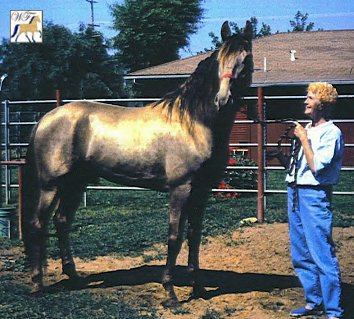 For
a month I wondered if I was daft. I'm a very conservative
person, and bought a very expensive horse, sight unseen,
primarily because of his color. By the time Champagne Look
walked out of Clark Ford's trailer at our stable in Elk
Grove, California on May 10, the whole neighborhood was
anxious to see what sort of creature was responsible for
Aunt Bea's "temporary insanity." For
a month I wondered if I was daft. I'm a very conservative
person, and bought a very expensive horse, sight unseen,
primarily because of his color. By the time Champagne Look
walked out of Clark Ford's trailer at our stable in Elk
Grove, California on May 10, the whole neighborhood was
anxious to see what sort of creature was responsible for
Aunt Bea's "temporary insanity."
No one
was disappointed. The tall, strong colt boldly marched down
the ramp and crowned himself king of his new domain. I had
barely let out my first long sigh of relief - the colt was
a dandy, well put together, great long stride, and a great
disposition according to Clark, who had just spent several
days on the road with him - when the questions started about
his color.
Some people who knew the colt was coming
phoned to ask, "What color is he?" Others who
had come to see for themselves would look right at him and
ask, "Well, what color is he?" The only answer
we had is "He's champagne-color." One lady had
called to say how exciting it was to have this young stallion
on the West Coast. She said, "I saw Champagne Lady
show many times, I've never forgotten her color, and you
can't describe it either, but if you ever see it - you never
forget it." Now we could see what she was talking about.
In a few days, I called Wiley to report on the colt's
safe arrival, and how pleased we were with him. Wiley had
great news. His Black Power mare had just had a champagne-colored
stud colt (by Champagne Night). Now there were four Champagne
horses! With the prospect of Champagne Lady's next foal
and our own mare safe in foal to Champagne Night, it looked
like we might be on the way.
August 1990, there came
some bad news from Wiley. Within days of foaling, old Champagne
Lady had died. What a shock and a loss! She wasn't autopsied,
so we'd never know what color foal she was about to deliver.
Her death made one less champagne-colored horse. There were
only three again.
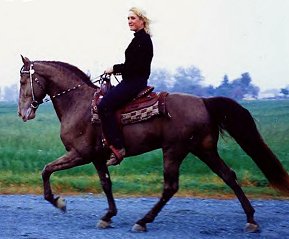 Everything
was falling into place in our breeding program, however.
Champagne Look grew fast, and in the fall of 1990 we accepted
two outside mares to be bred, a brown Super Stock mare and
a gray Sun Dust mare. We had several others scheduled for
spring breeding. Breeding mares to Look brought all the
wonderful anticipation kids experience at Christmas. As
soon as the mare was checked in foal, we'd all start wondering
what was inside her. And we still wondered what color we
were dealing with. Everyone had a theory. They would come,
go over Look like Sherlock Holmes looking for clues, and
you could almost see the question mark start to form over
their heads. Look loved the attention. They all brought
cameras. Look loved to pose. The photos did not reproduce
the color well, however. Sometimes it came out lavender,
sometimes gold, and sometimes even greenish! And the coat
was not just a weird color, it was a weird texture, too.
Even in the dead of winter Look was slick and shiny. And
he was not kept blanketed or even in a stall. Everything
was falling into place in our breeding program, however.
Champagne Look grew fast, and in the fall of 1990 we accepted
two outside mares to be bred, a brown Super Stock mare and
a gray Sun Dust mare. We had several others scheduled for
spring breeding. Breeding mares to Look brought all the
wonderful anticipation kids experience at Christmas. As
soon as the mare was checked in foal, we'd all start wondering
what was inside her. And we still wondered what color we
were dealing with. Everyone had a theory. They would come,
go over Look like Sherlock Holmes looking for clues, and
you could almost see the question mark start to form over
their heads. Look loved the attention. They all brought
cameras. Look loved to pose. The photos did not reproduce
the color well, however. Sometimes it came out lavender,
sometimes gold, and sometimes even greenish! And the coat
was not just a weird color, it was a weird texture, too.
Even in the dead of winter Look was slick and shiny. And
he was not kept blanketed or even in a stall.
Finally,
when our vet, Dr. Stephen Leonard, came to check some horses,
he said, "I've been talking to my associates about
Look, and we want you to call Dr. Ann Bowling at the University
of California at Davis. She's a nationally-recognized geneticist
who is an authority on equine color, and we believe she
should see Look."
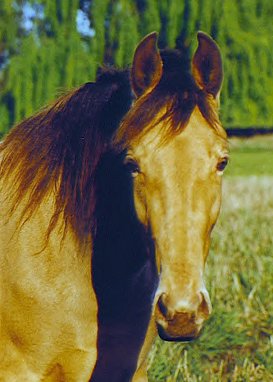 I
thanked him, but I wanted to wait until after our mare,
who was in foal to Look's brother, gave birth in mid May.
It would give Dr. Bowling that much more to work with. I
believed with all my heart and soul that the mare would
have a champagne-colored foal. I
thanked him, but I wanted to wait until after our mare,
who was in foal to Look's brother, gave birth in mid May.
It would give Dr. Bowling that much more to work with. I
believed with all my heart and soul that the mare would
have a champagne-colored foal.
In early May, the
vet came back to draw blood for typing Look. "What
color is he?" he asked. "What color do I enter
for the record?"
"Just write 'champagne-color',"
I answered.
"Didn't you call Dr. Bowling?"
"No, our mare is only 10 days from foaling,"
I explained. "Patience, Doctor, patience. We're not
breeding mice, you know! We just have to wait."
On May 15th at 4:30 a. m. our mare delivered her long-awaited
package. It was just what I wanted for Christmas in May
. . . a big champagne-colored filly! I'll spare you all
the details and excitement of her birth, except to say there's
no mistaking a champagne foal. It's born champagne-colored,
with pink skin and bright blue eyes. Mother and daughter
were fine. Daylight came. I looked at the filly and said, "Touché!"
So we named her "Champagne Touche." And wrote "champagne-color"
on her registration application. This baby brought the number
of champagne-colored horses back up to four again.
By August there were seven outside mares in foal to
Look. I had been keeping good records on them, documenting
the color of the mare and the color of her ancestors as
far back as we could. When it looked like everything was
under control, I called Dr. Bowling and gave her a brief
explanation. She made an appointment for August 10, 1991,
to come and examine the horses.
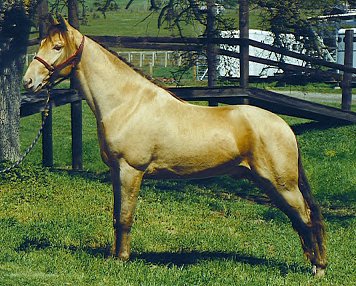 The
next couple of days were full of anticipation. Would she
say, "Oh, that's an isabella." Or, "Yes,
you see these diluted buckskins once in a while." A
thousand possibilities ran through my mind. The
next couple of days were full of anticipation. Would she
say, "Oh, that's an isabella." Or, "Yes,
you see these diluted buckskins once in a while." A
thousand possibilities ran through my mind.
Dr. Ann
and her husband Mike (who is the photographer of the duo,
and is a geneticist knowledgeable in equine colors as well)
finally arrived. My heart pounding, I led Look out. The
moment of truth.
No one spoke. Dr. Bowling was carrying
a pad and pen as she walked around the horse. Then she and
Mike started discussing him, she making notes, he taking
photos. I answered their questions when asked. Dr. Ann collected
hair samples and continued to exchange comments with Mike.
Their examination and evaluation with Look took about
40 minutes, then they turned their attention to Touche.
I explained her startling blue eyes at birth. Almost 3 months
old now, the filly's eyes now appeared more amber-green.
I led Touche over to Look. Mike took more pictures and they
both agreed the horses were the same color.
When
we returned to the house, I showed them the records I was
keeping. I told them about Diane Green giving Champagne
Lady's hair samples to the two universities, and the lack
of an answer. Several times Dr. Bowling said, "I'm
not going on record yet" . . . or "I'm not ready
to go on record. . . "
The suggestion was made that
this color might be a diluted black. Dr. Bowling had seen
a color very similar to this in a grade Icelandic pony.
We all had a good laugh when Mike asked her, "Ann,
what color did they call that?"
"I don't know,"
she smiled, "I don't speak Icelandic."
I was left with instructions to keep up the documentation,
try breeding to sorrels, chestnuts, palomino and cremellos,
and to keep them informed when the foals came. A decision
could not be made until Look has 25 or 30 foals.
So the
question is still "What color is that horse?"
And my answer is still "champagne-color." I sincerely
believe we are on the edge of documenting a new color in
American horse breeds.
As of today, Look has three
foals on the ground. They are all champagne-colored, and
they are out of 3 different colored mares - chestnut, brown
and light sorrel. Look's brother Champagne Night has sired
1 more - there are now 8 champagne-colored horses in the
world.
It all started June 19, 1969, when Champagne
Lady was born. A genetic color accident? Maybe nature's
attempt to keep Tennessee Walking Horses a colorful breed.
And the best part about this color is that it comes wrapped
around descendants of a grand old show mare that exhibited
all the best characteristics of our breed. [It
is now known that Mack's Golden Girl H., Champagne Lady's
dam, was a gold champagne and that the champagne gene has
been in existence for much longer than was originally thought.]
|